All posts by Matt Philleo

How to Draw Facial Features in Pencil Sketch
Learn how to draw realistic facial features with pencil sketch techniques—Tips for perfecting eyes, nose, lips, and more.
Drawing realistic facial features in a pencil sketch requires attention to detail, patience, and a clear understanding of proportion and shading. Whether you’re working on a self-portrait or creating a likeness of someone else, refining key elements such as the eyes, nose, and lips is essential to achieving a lifelike representation. In this guide, we will walk you through the process of drawing facial features with a focus on capturing the unique characteristics of each part of the face.
Getting Started with Basic Outlines
In the initial phase of drawing, it is important to loosely block in the outlines of the facial features. This helps establish the general proportions and placement of the eyes, nose, mouth, and other elements. A 2H pencil is recommended for these initial light strokes since it produces faint lines that are easier to adjust as needed.
- Grid Method: Using a grid is a helpful tool to maintain the correct proportions and ensure that facial features are aligned accurately. Lightly sketch the outlines of the eyes, nose, lips, and overall head shape using the grid as a guide.
- Basic Shapes: The eyes are often drawn as almond shapes or football-like structures, but it’s essential to avoid making them overly stylized or cartoony. Each person’s eyes differ in size and shape based on their eyelids and other factors.
Drawing the Eyes
Eyes are arguably the most important feature when it comes to capturing expression and realism in a portrait. The goal is to draw them in a way that reflects their actual appearance rather than relying on preconceived ideas of how eyes look.
- Shape of the Iris and Pupil: Start by drawing the iris, the round part of the eye. It’s common for beginners to make the iris appear too flat or symmetrical, but this doesn’t account for natural variations in eye shape. The pupil is drawn in the center of the iris but with care taken to ensure it looks natural.
- Upper Eyelid and Fold: The upper eyelid often casts a shadow over the iris, creating depth in the eye. Add the crease or fold above the eyelid if applicable—this fold is more prominent in some people and less so in others. Remember, eyes appear squintier in some angles, so adjust based on your reference.
- Reflection in the Eye: A small highlight or reflection is usually seen on the surface of the eye, which should be placed carefully. This reflection comes from light sources in the environment and adds a realistic touch.
- Adding Eyelashes and Eyebrows: Be subtle when drawing the eyelashes—overdoing it can make the portrait look exaggerated. For eyebrows, use soft, feathered strokes to simulate the hair texture, paying attention to the density and shape.
Refining the Nose
The nose can be tricky due to its three-dimensional structure, but using shading can greatly assist in creating depth and realism.
- Nostril Shape: Focus on drawing the correct nostril shapes without making them too bold. The nostrils should not be drawn as harsh, circular outlines but rather suggested through soft shading and curvature.
- Shading and Contours: The nose has subtle curves and contours that require delicate shading. The areas around the nose bridge and the sides should be shaded to indicate depth. Pay close attention to the light source, as it will dictate where shadows fall.
Drawing the Mouth and Teeth
The mouth, especially the lips, can define the emotion and personality of the subject.
- Shape of the Lips: When drawing the lips, focus on the shape and volume of both the upper and lower lips. The upper lip typically has a more defined curve, while the bottom lip is fuller. The key is to use shading to indicate the volume rather than relying on harsh outlines.
- Teeth Placement: When drawing teeth, avoid drawing each tooth with equal emphasis. The front two teeth are generally more prominent, while the side teeth appear smaller due to perspective. Pay attention to how the teeth curve in the mouth, as they are never viewed head-on in a natural smile.
- Creases and Shadows: The small crevices or gaps between the teeth and lips, as well as the shadow under the bottom lip, are essential for a realistic representation. These areas should be subtly shaded to create depth and natural transitions between features.
Adding Final Details and Shading
At this stage, your portrait will have all the major features sketched out. Now, it’s time to refine the details and add depth through shading.
- Refining the Eyes: Darken the pupil slightly while maintaining the reflection highlight. Add more definition to the iris by shading its outer edges lightly.
- Highlighting with Erasers: Use a kneaded eraser to pick out highlights, especially on the cheekbones, tip of the nose, and the top of the upper lip. This helps to bring out the areas that naturally catch more light.
- Blending for Smooth Transitions: Use a blending stump or tissue to soften harsh lines and blend shading smoothly across the face. This helps create a realistic, three-dimensional effect, especially around curved areas like the cheeks and forehead.
- Layering Shading: Build up the depth of the sketch by gradually darkening certain areas, such as the eyes, nostrils, and under the chin. Shading should be applied in layers rather than all at once to give more control over the darkness and contrast.
Tips and Techniques for a Realistic Pencil Sketch
- Use Reference Photos: Always refer back to your subject or a reference image, as it’s easy to fall into drawing features as you think they look rather than how they truly appear.
- Be Patient with Details: Taking the time to refine small details, such as the reflections in the eyes or the shadows around the nose, can make a significant difference in the overall realism of your drawing.
- Avoid Over-Shading: While shading adds depth, too much shading can flatten the image or create unnecessary contrast. Subtle transitions between light and dark areas are key.
- Stay Loose in the Early Stages: Keep your lines loose and light during the blocking stage. It’s easier to adjust proportions and correct mistakes if the initial lines are not too bold.
- Use the Grid Method: If you’re struggling with proportions, a grid can help break down the facial features into smaller, manageable sections, making it easier to replicate accurately.
By following these steps and techniques, you will be well on your way to creating a lifelike and expressive pencil sketch portrait. Remember, practice is essential, and over time, you’ll improve your ability to capture the subtle details that make each face unique.
If you’re looking for more instructional videos on how to improve your acrylic painting, visit www.realisticacrylic.com for more tutorials and check out my free courses here. . Happy painting.
- Adding highlights to your acrylic painting
- 5 Excellent Reasons to Use Aluminum Foil
- Paint Realistic Wrinkles in Acrylic
- Painting Clothing in an Acrylic Portrait
- Paint a Cloudy Sky Acrylic
- How to add Semi-Opaque Highlights
- How to Enhance the Contrast in Your Acrylic
- How to Add Glaze to Your Acrylic Painting
- Paint Realistic Reflections on Eyeglasses in an Acrylic Portrait
- Build Up Depth on Your Acrylic Portrait Backgrounds
- How Do You Do Layers With the Glazing Technique?
- Learn How to Paint Wrinkles in Acrylic
Read more about how to paint a portrait that you can surely be proud of!
I’d love to hear your thoughts on this video. Please share it with your friends and family. Let me know if you have any further questions. I’ll greatly help you.
If you’d like to learn more, sign up for my free email tips and video class today.
Learn How to Paint Acrylic Portraits With My Free Mini-Video Course!
Thank you so much for taking the time to read this tutorial and watch the video. That means a lot to me. I hope you find it very helpful in your portrait painting.
Yours for Better Portraits,

P.S. Did you find this post helpful or encouraging? If so, send it on ahead! Let others know with the share buttons below. I’d love to hear your comments. Thank you so much! Also, do you have a question on acrylic portrait painting you’d like answered? Let me know, and I’d be happy to help!
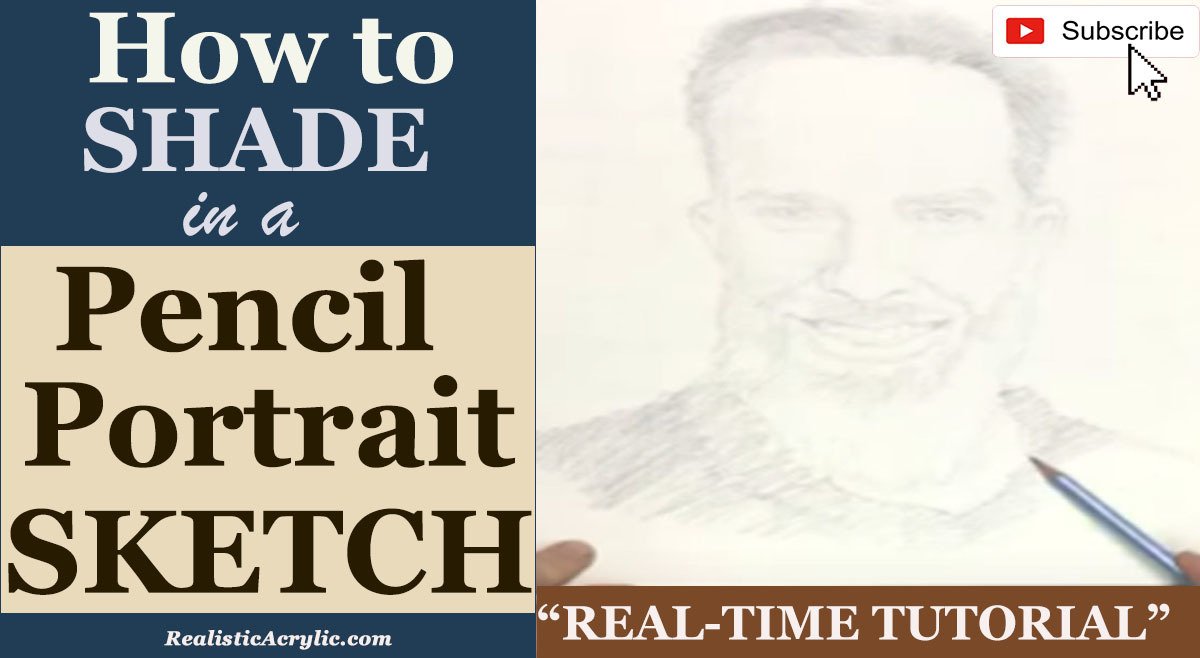
How to Shade in a Pencil Portrait Sketch
Let me show you a few techniques for shading in your pencil portrait sketch.
Shading is a critical component of any pencil portrait, bringing your drawing to life by adding depth, dimension, and a sense of realism. Whether you are a novice or an experienced artist, understanding how to shade effectively can make a massive difference in your sketches. This guide will walk you through various shading techniques and how to shade in a pencil portrait sketch, from pencil selection to advanced methods like cross-hatching, to help you improve your portrait sketches.
Understanding Pencil Grades and Their Use in Shading
The first thing to consider when shading is the type of pencil you’re using. Pencils come in various grades, each defined by its hardness or softness. The softer the lead, the darker the shade, and the harder the lead, the lighter the shade. Here are some essential grades to keep in mind:
- HB: The middle ground pencil, suitable for both shading and sketching.
- 2B: Slightly softer and darker than HB, great for medium shading.
- 4B: Darker still, perfect for deep shadows and contrast.
- 2H: A hard lead pencil that is ideal for light areas and highlights.
For most portrait shading, artists tend to use HB, 2B, and 4B pencils. However, if you’re looking to add more subtle details and gentle transitions, consider adding a 2H pencil to your collection.
Tight Pencil Strokes for Controlled Shading
One of the fundamental methods of shading is using tight, controlled pencil strokes. This technique allows for precision and uniformity in the shaded area, especially when working on smaller, detailed sections of your portrait, like clothing folds or facial features.
To create these strokes, move your pencil in short, overlapping lines without leaving gaps. This ensures that the shading appears smooth and continuous. It’s important not to rush this process; larger, loose strokes can result in visible gaps that may detract from the overall smoothness of your shading.
Additionally, if you need to shade a larger area, you can layer your strokes by overlapping them in a method known as cross-hatching.
Cross-Hatching for Building Depth
Cross-hatching is a popular shading technique that involves layering pencil strokes at different angles to build depth and create varied levels of shadow. Start by drawing a set of parallel strokes at a 45-degree angle. Once you’ve covered the area, rotate your paper slightly and layer another set of strokes in the opposite direction.
For even more depth, you can add a third set of strokes, creating a crisscross pattern that enhances the sense of volume and shadow in your portrait. The more layers you add, the darker the shading will appear. However, it’s essential to maintain consistency in the direction and spacing of your strokes to avoid an uneven or patchy look.
Cross-hatching works exceptionally well for areas that require strong contrast, such as shadows cast by the nose or under the chin in a portrait.
Gradation: Fading from Dark to Light
Gradation is a critical aspect of shading that helps create smooth transitions from dark to light areas, mimicking the effect of light falling on an object. In portrait sketching, achieving smooth gradation is essential for adding realism to features like the cheeks, forehead, or neck.
To create gradation, start with heavy pressure on your pencil in the darkest areas and gradually reduce the pressure as you move toward the lighter areas. For subtle transitions, use a harder pencil like a 2H to finish the lighter zones, or simply lift your pencil off the paper slightly as you shade.
Alternatively, you can layer different pencil grades to achieve a smoother transition. Begin with a 4B pencil for the darkest areas, then blend in an HB pencil as you move into mid-tones, and finish with a 2H pencil for the lightest areas.
Blending for Smooth Shading
For ultra-smooth shading, blending can be a highly effective technique. Rather than relying solely on your pencil to create transitions, you can blend your shading using a soft tissue or a blending stump. Lightly rub the shaded area in a circular motion to smooth out harsh lines and create a more seamless gradation.
However, blending should be used sparingly. Over-blending can result in a muddy appearance, losing the crispness of your drawing. It’s essential to do most of your shading with the pencil and only blend when necessary to soften transitions.
Tip: Avoid using your fingers to blend, as the oils from your skin can smudge the graphite and leave unwanted marks on your paper. A clean tissue or blending tool will ensure a more professional result.
Shading Larger Areas with Side Grip
When shading larger areas like backgrounds or clothing, consider using the side grip technique. Hold the pencil horizontally, resting the lead on the side of your thumb, with the pencil positioned under your index finger. This grip allows for broader, smoother strokes that cover more ground quickly.
The side grip works well when you’re going for a rougher, sketch-like quality, as it produces a softer, grainier texture compared to the tight strokes method. For instance, if you’re sketching a sweater or textured fabric, this technique can convey the material’s softness and volume effectively.
Adding Shadows to Define Form
Shadows are crucial for defining the structure and form of your subject in a portrait. To create realistic shadows, observe where the light source is positioned. The areas farthest from the light source will be the darkest, while the areas closest to it will remain light.
For example, when shading the face, the underside of the nose, the hollows of the cheeks, and the area under the chin will typically require darker shading. By carefully observing the play of light and shadow, you can create a more convincing sense of depth and form in your portrait.
Tip: Use gradual transitions when shading shadows. Avoid sudden shifts from light to dark, as this can make the drawing appear flat or unrealistic. Instead, use cross-hatching or light strokes to slowly build up the shadow intensity.
Final Touches: Refining the Details
Once the major areas of your portrait are shaded, it’s time to refine the details. This step involves going back over areas to deepen shadows, enhance highlights, and ensure smooth transitions. Use your eraser as a drawing tool to lift graphite from areas where you want to emphasize highlights, such as the tip of the nose, cheekbones, or forehead.
Adding fine details like hair strands or subtle texture in the skin can also enhance the realism of your portrait. Use sharp pencils and light strokes for these final touches to avoid overpowering the delicate shading.
Conclusion
Shading is the foundation of any realistic pencil portrait, and mastering it will take your sketches to the next level. By using techniques like cross-hatching, gradation, blending, and the side grip, you can create rich, dynamic portraits full of depth and life. Practice each technique carefully, and over time, you’ll see a noticeable improvement in the realism and texture of your sketches.
With dedication and these practical tips, your pencil portraits will exude a sense of professionalism and artistry.
If you’re interested in learning more about acrylic glazing or portrait painting techniques, be sure to explore the resources available at RealisticAcrylic.com. and download my free gift for you here. With practice, you’ll be able to master this technique and bring your portraits to life with rich depth and realism.
- Adding highlights to your acrylic painting
- 5 Excellent Reasons to Use Aluminum Foil
- Paint Realistic Wrinkles in Acrylic
- Painting Clothing in an Acrylic Portrait
- Paint a Cloudy Sky Acrylic
- How to add Semi-Opaque Highlights
- How to Enhance the Contrast in Your Acrylic
- How to Add Glaze to Your Acrylic Painting
- Paint Realistic Reflections on Eyeglasses in an Acrylic Portrait
- Build Up Depth on Your Acrylic Portrait Backgrounds
- How Do You Do Layers With the Glazing Technique?
- Learn How to Paint Wrinkles in Acrylic
Read more about how to paint a portrait that you can surely be proud of!
I’d love to hear your thoughts on this video. Please share it with your friends and family. Let me know if you have any further questions. I’ll greatly help you.
If you’d like to learn more, sign up for my free email tips and video class today.
Learn How to Paint Acrylic Portraits With My Free Mini-Video Course!
Thank you so much for taking the time to read this tutorial and watch the video. That means a lot to me. I hope you find it very helpful in your portrait painting.
Yours for Better Portraits,

P.S. Did you find this post helpful or encouraging? If so, send it on ahead! Let others know with the share buttons below. I’d love to hear your comments. Thank you so much! Also, do you have a question on acrylic portrait painting you’d like answered? Let me know, and I’d be happy to help!
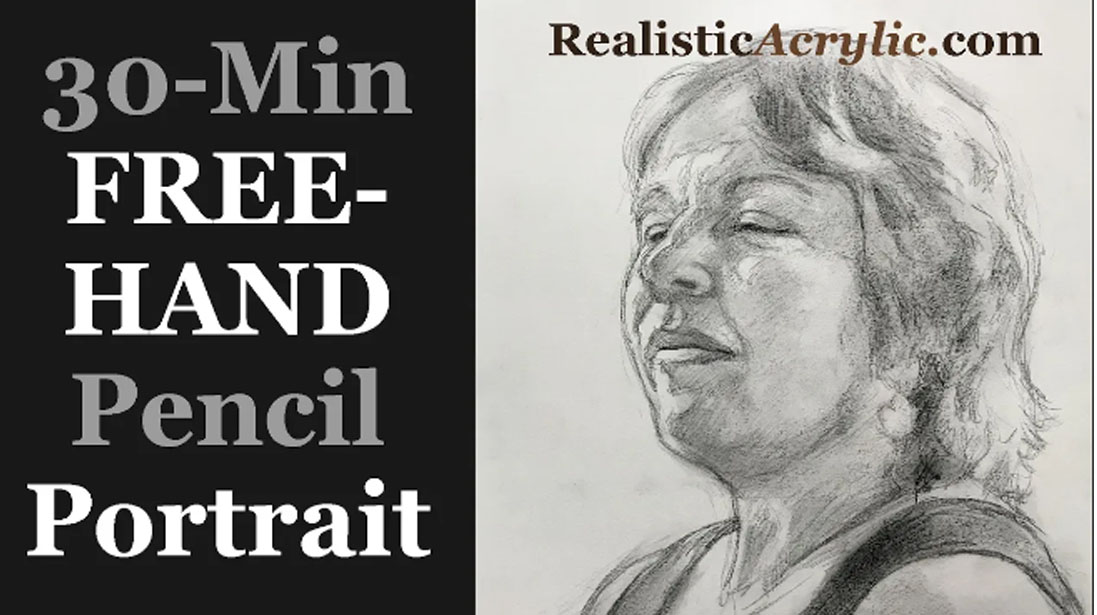
How to Do Freehand Portrait Sketch in 30 Minutes
Learn the essential techniques to sketch a freehand portrait in just 30 minutes and bring your artistic vision to life with accuracy and style.
Sketching a portrait freehand can seem daunting, but with the right techniques and approach, it’s entirely possible to create a compelling likeness within just 30 minutes. In this tutorial, I’ll take you through my process of sketching a portrait freehand, then share tips on proportions, shading, and how to bring out essential features. Whether you’re an experienced artist or a beginner, this guide will provide you with the tools and techniques needed to boost your portrait sketching skills.
Getting Started: Blocking In the Proportions
The first step in freehand portrait sketching is to block in the overall proportions of the face. Because you don’t need to focus on details right away. You can first start by lightly sketching the outline of the head, and then the placement of the eyes, nose, mouth, and neck. In this case, you will use a graphite pencil, charcoal, or even a lead stick whichever medium you’re comfortable with.
It’s important to remember that these first lines are just guidelines. Then don’t be afraid to make changes and adjustments as you go along. Here is the following tips to keep in mind:
- Use light strokes at the beginning to avoid deep indents on the paper.
- Start by marking the key landmarks: the top of the head, the chin, and the midpoint where the eyes will sit.
- Work quickly but with purpose, aiming to capture the basic structure within the first few minutes.
Tip: To help with proportion accuracy, visualize where key features (like the nose and mouth) sit in relation to one another.
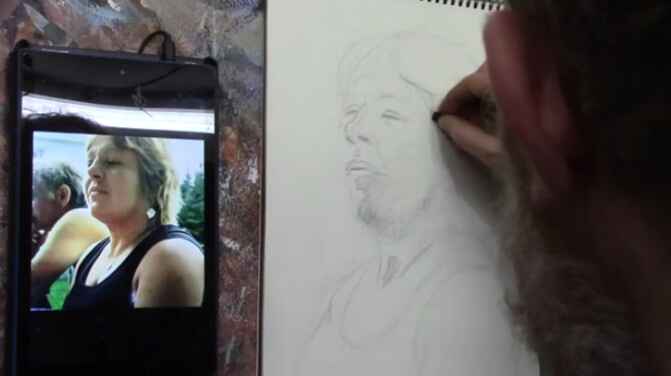
Focusing on Facial Features
Once you have the basic structure of the head blocked in, it’s time to focus on adding the facial features. This includes the eyes, nose, and mouth then each of which plays a crucial role in making your sketch recognizable. Here’s how to tackle them:
- Eyes: Start with the placement of the eyes. The space between the eyes is usually about the width of one eye. When sketching freehand, make sure to position the eyes symmetrically. If the head is turned, one eye might be closer to the nose than the other.
- Nose: The nose sits roughly halfway between the eyes and the chin. If the face is tilted, adjust the length of the nose to match the perspective.
- Mouth: The distance from the bottom of the nose to the chin usually equals the space between the eyes. Pay close attention to the shape of the lips, as this can convey emotion and expression.
As you sketch, always take note of angles and proportions. For instance, if the subject’s head is slightly tilted upwards, the nose will appear closer to the eyes. Because this adjustment will ensure your portrait looks lifelike.
Tip: Use a kneaded eraser to make small corrections without disturbing the entire sketch.
Shading and Adding Depth
Shading is where the sketch starts to come to life. Then first begin by identifying light and shadow areas on the face. For example, notice where the light hits the subject’s forehead, cheekbones, and chin, and where shadows form under the nose, around the eyes, and along the neck.
Here’s the following how to approach shading:
- Use the side of your pencil or shading tool to create broad, soft shadows.
- Layer your shading gradually. Start light and darken as needed, paying attention to where the light source is coming from.
- Blend your shading with a tissue or blending stump to smooth transitions between light and dark areas.
Areas like the cheekbones, jawline, and neck often require more subtle shading to give the face a three-dimensional look. Keep your strokes consistent and follow the natural contours of the face.
Tip: Take extra care when shading the eyes and mouth, as these features often draw the viewer’s attention and define the likeness of the portrait.
Refining the Details
After blocking in and shading, it’s time to refine the finer details. Then just focus on key features like the eyes, lips, and hair, which can make or break the realism of the portrait.
- Eyes: Add highlights to the pupils, define the eyelids, and make sure the eyes are aligned properly.
- Lips: Define the shape of the lips, taking care to include subtle shading around the mouth to indicate volume and light.
- Hair: Use long strokes to suggest the texture and flow of the hair. Darker strokes can define the hairline and areas where the hair casts shadows on the face or neck.
The eyebrows and eyelashes should also be refined at this stage. It’s easy to overdo them, so keep your strokes light and controlled, focusing on the natural shape and thickness of these features.
Final Touches and Polishing
As you near the end of your 30-minute session, take a step back and review your work. Make any final adjustments to proportions and shading. Sometimes, a small tweak—such as lowering an eye or softening a shadow—can make a big difference in the overall effect.
Use your eraser to lighten highlights or fix any areas that seem too dark. Smooth out any rough areas with a tissue or blending tool, and make sure your portrait has a clean and polished look.
If time permits, add details to the subject’s clothing or background to complete the portrait. However, remember that the goal is to finish within 30 minutes, so focus primarily on the face and key features.
Tips for Successful Freehand Portrait Sketches
- Practice Regularly: The more you sketch freehand, the better you’ll become at understanding proportions and facial structure.
- Observe Carefully: Pay attention to your reference or model, noting the unique angles and proportions of the face.
- Start Light, Build Layers: Begin with light sketching, and gradually add darker lines and shading as your sketch progresses.
- Use a Variety of Tools: Experiment with different types of pencils and shading tools to find what works best for you.
- Stay Relaxed: Sketching quickly doesn’t mean you have to rush. Stay relaxed and enjoy the process.
Conclusion
Sketching a freehand portrait in 30 minutes is a fantastic exercise in speed, accuracy, and observation. Because by focusing on proportions, shading, and detail refinement, you can create a compelling likeness of your subject within a short time frame. Always remember that practice makes perfect then each sketch you complete helps you improve your artistic abilities.
If you’re looking for more instructional videos on how to improve your acrylic painting, visit www.realisticacrylic.com for more tutorials and check out my free courses here. .
- Adding highlights to your acrylic painting
- 5 Excellent Reasons to Use Aluminum Foil
- Paint Realistic Wrinkles in Acrylic
- Painting Clothing in an Acrylic Portrait
- Paint a Cloudy Sky Acrylic
- How to add Semi-Opaque Highlights
- How to Enhance the Contrast in Your Acrylic
- How to Add Glaze to Your Acrylic Painting
- Paint Realistic Reflections on Eyeglasses in an Acrylic Portrait
- Build Up Depth on Your Acrylic Portrait Backgrounds
- How Do You Do Layers With the Glazing Technique?
- Learn How to Paint Wrinkles in Acrylic
Read more about how to paint a portrait that you can surely be proud of!
I’d love to hear your thoughts on this video. Please share it with your friends and family. Let me know if you have any further questions. I’ll greatly help you.
If you’d like to learn more, sign up for my free email tips and video class today.
Learn How to Paint Acrylic Portraits With My Free Mini-Video Course!
Thank you so much for taking the time to read this tutorial and watch the video. That means a lot to me. I hope you find it very helpful in your portrait painting.
Yours for Better Portraits,

P.S. Did you find this post helpful or encouraging? If so, send it on ahead! Let others know with the share buttons below. I’d love to hear your comments. Thank you so much! Also, do you have a question on acrylic portrait painting you’d like answered? Let me know, and I’d be happy to help!
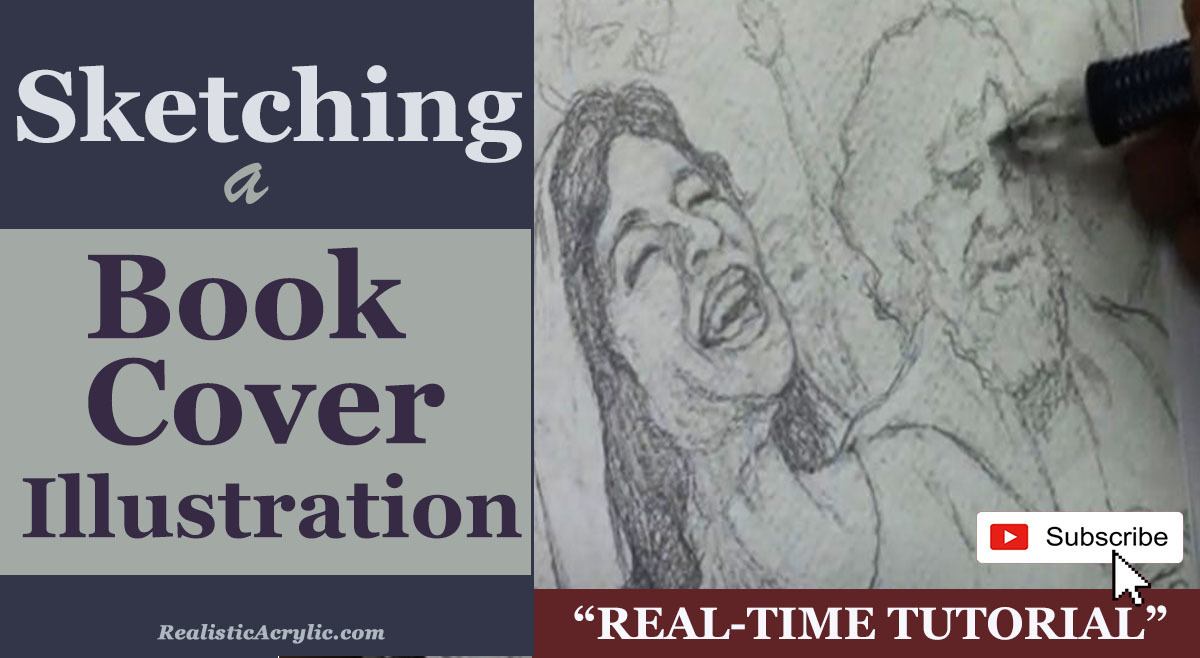
How to Sketch Book Cover Illustration
I’ll show you a sketching book cover illustration.
When creating a sketch for a book cover illustration it is a rewarding and meticulous process that blends creativity with technical skill. In this tutorial, I’ll walk through the steps of sketching a book cover illustration for a Bible commentary, focusing on capturing emotion and detail in every stroke. By the end of this guide, you’ll have actionable techniques to apply to your own projects, whether you’re a beginner or an experienced artist.
In this example, we explore the sketching process for a cover that illustrates the Pentecostal movement from the Book of Acts. This moment depicts the disciples receiving the Holy Spirit, with dramatic expressions of joy and intensity. Let’s dive into the step-by-step process of creating this compelling piece of art.
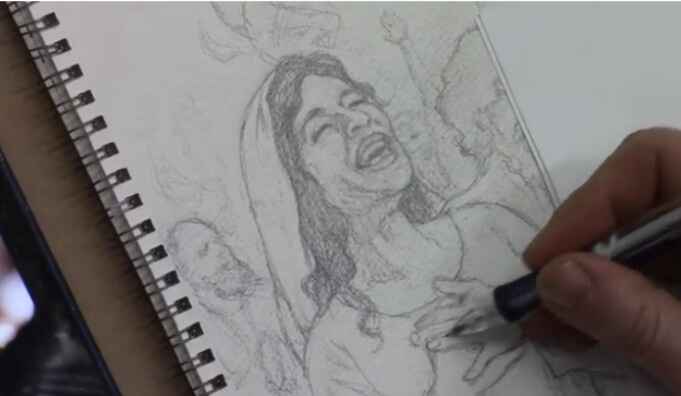
Step 1: Conceptualizing the Scene
Before starting any sketch, it’s important to have a clear understanding of the subject matter. In this case, the illustration revolves around a significant biblical event, the arrival of the Holy Spirit during Pentecost, described in the Book of Acts. To capture this effectively:
- Research the event: Familiarize yourself with the story by reading the relevant biblical passages. Because this will help you grasp the mood and energy needed for your sketch.
- Determine the key emotions: The illustration should evoke excitement, awe, and spiritual reverence. These emotions will be conveyed through the expressions of the characters and their body language.
- Find reference images: Utilize online reference photos to help with anatomy, facial expressions, and positioning.
In this sketch, the focal point is a woman’s expression of joy, symbolizing the elation felt by the disciples as they received the Holy Spirit.
Step 2: Start with a Rough Sketch
The first stage of creating any illustration is a rough sketch to establish the composition. For this book cover, the sketch began by blocking in the figures and their general positions.
- Freehand drawing: Start by sketching freehand, focusing on the placement and proportion of the characters. This allows for flexibility as you adjust the positioning of different elements.
- Keep it loose: At this stage, don’t worry too much about details. Use light lines to outline the figures and the background. This will give you a basic framework to build on.
Tips for Freehand Sketching:
- Use loose, flowing strokes to keep the composition dynamic.
- Focus on proportions but don’t stress about perfect accuracy early on.
- Keep erasing and refining the composition as needed.
Step 3: Refining the Details
Once the rough sketch is laid out, it’s time to refine the characters and bring out the key details that will make your illustration pop. Because in this project, we will focuses on capturing facial expressions and hand positioning, which are critical for conveying emotion.
Facial Expressions and Hands:
- Faces: Pay special attention to the expressions on your characters’ faces. For this sketch, one figure’s face is drawn with joy, while another figure shows intensity through a furrowed brow and a praying posture.
- Hands: Hands are often one of the hardest parts to draw accurately, but they are essential in conveying emotion. Here, the woman has her hands on her chest, adding to the sense of awe, while another figure has clasped fingers, indicating deep prayer.
Refining these elements involves carefully erasing and reworking lines to get the right anatomy and expression. For example, the wrinkles around the eyes or the positioning of the fingers can greatly impact the emotional depth of the characters.
Technique for Adding Expression:
- Use reference images: Don’t hesitate to consult images to ensure your anatomy and expressions are realistic.
- Focus on the eyes: Eyes are windows to the soul, so ensure they capture the right emotion.
- Subtle shading: Add light shading to emphasize features such as wrinkles, folds, or muscle tension in the hands.
Step 4: Working with Watercolor Paper
In this illustration, watercolor paper was used as the base for the sketch. This surface provides a bit more texture and grip than traditional drawing paper, making it ideal for illustrations that will later be painted.
Benefits of Watercolor Paper for Sketching:
- The texture holds pencil marks well, allowing for smoother shading and erasing.
- It’s sturdy enough to withstand multiple layers of detail, which is beneficial when transitioning from sketching to painting.
Step 5: Final Adjustments and Preparing for Paint
At this point in the sketch, the major elements of the illustration are in place. The characters are well-formed, and their emotions are clearly conveyed through their body language and expressions. However, there are always small adjustments that can be made to improve the sketch before painting.
Making Final Adjustments:
- Shadows and depth: Add subtle shading to the clothing and faces to create depth. For instance, a shadow under the man’s beard gives his face more structure.
- Refine small details: Pay attention to small details like the lines of the fingers or the folds in clothing. Then these small adjustments can make a big difference in the realism of the sketch.
Tips for Transitioning to Paint:
- Ensure that the sketch is as clean and detailed as possible. This will serve as the foundation for the painting stage.
- Consider how your paint medium (whether watercolor, acrylic, or oil) will interact with the pencil lines. Light sketching can easily be painted over, while heavier pencil marks might need to be minimized.
Conclusion
Sketching a book cover illustration requires both creativity and attention to detail. Because by focusing on freehand drawing, refining expressions, and making adjustments based on reference photos, you can create a compelling and emotionally charged sketch. In this project, the sketch captures the pivotal moment of Pentecost, filled with joy and intensity, and lays a solid foundation for a beautiful painted illustration.
If you found this guide helpful and would like to learn more about sketching or painting techniques, visit realisticacrylic.com for more tutorials and check out my free gift for you here
- Adding highlights to your acrylic painting
- 5 Excellent Reasons to Use Aluminum Foil
- Paint Realistic Wrinkles in Acrylic
- Painting Clothing in an Acrylic Portrait
- Paint a Cloudy Sky Acrylic
- How to add Semi-Opaque Highlights
- How to Enhance the Contrast in Your Acrylic
- How to Add Glaze to Your Acrylic Painting
- Paint Realistic Reflections on Eyeglasses in an Acrylic Portrait
- Build Up Depth on Your Acrylic Portrait Backgrounds
- How Do You Do Layers With the Glazing Technique?
- Learn How to Paint Wrinkles in Acrylic
Read more about how to paint a portrait that you can surely be proud of!
I’d love to hear your thoughts on this video. Please share it with your friends and family. Let me know if you have any further questions. I’ll greatly help you.
If you’d like to learn more, sign up for my free email tips and video class today.
Learn How to Paint Acrylic Portraits With My Free Mini-Video Course!
Thank you so much for taking the time to read this tutorial and watch the video. That means a lot to me. I hope you find it very helpful in your portrait painting.
Yours for Better Portraits,

P.S. Did you find this post helpful or encouraging? If so, send it on ahead! Let others know with the share buttons below. I’d love to hear your comments. Thank you so much! Also, do you have a question on acrylic portrait painting you’d like answered? Let me know, and I’d be happy to help!
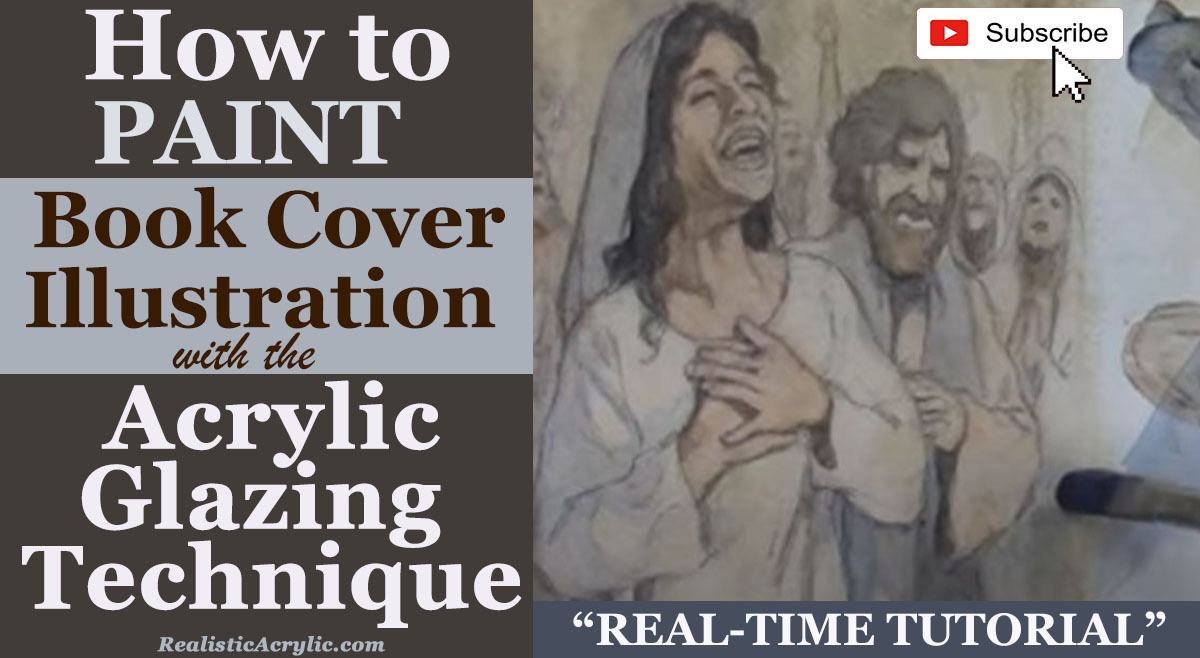
How to Paint a Book Cover Illustration: Glazing Technique
Learn the acrylic glazing technique to create stunning book cover Illustrations with depth and vibrancy
Creating a book cover illustration that tells a story visually and emotionally requires a combination of artistic skill, technique, and a deep understanding of the subject. In this tutorial, I’ll walk you through how to paint a book cover illustration using the acrylic glazing technique to achieve stunning results with rich depth, vibrant colors, and luminosity.
What is the Acrylic Glazing Technique?
The acrylic glazing technique involves applying multiple thin layers of translucent paint mixed with matte medium to create depth and a glowing, luminous effect. The glazing process allows light to pass through the layers, which builds color intensity and gives the painting a rich, oil-like appearance. It is perfect for capturing the complexity and atmosphere needed in book cover illustrations, where light, shadows, and vibrancy are essential.
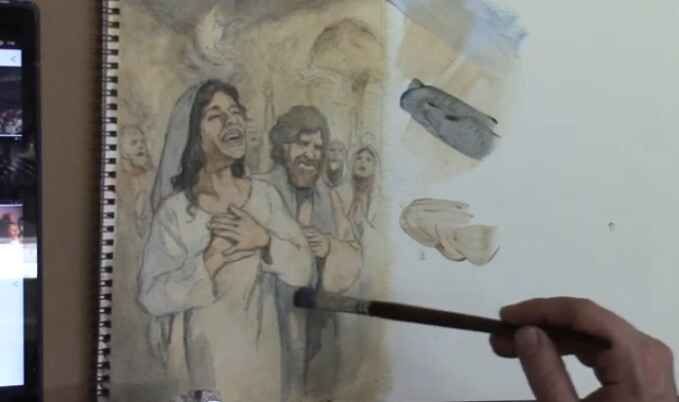
Step-by-Step Guide to Creating a Book Cover Illustration with Glazing
Let’s dive into how I applied this method to paint a book cover illustration for a novel about the Holy Spirit falling on early disciples, based on the book of Acts. This is a spiritual and dramatic scene that requires both light and darkness to emphasize the event’s importance.
1. Start with a Detailed Sketch
To begin, create a detailed sketch of your composition. This is crucial because the glazing technique builds on these initial lines. You’ll want to ensure your sketch is solid, as each layer of glazing will enhance, rather than obscure, the underlying structure.
2. First Layer: Laying the Foundation
Mix a small amount of paint with a large amount of matte medium. This thins out the paint, making it semi-transparent. Apply the first layer of paint to your illustration, ensuring that your strokes are smooth and even. For my painting, I used a base of ultramarine blue and raw sienna to establish the shadows and overall color scheme. Keep the first few layers lighter since you will be building up darker values later.
3. Building Depth Through Dark Values
Once your foundation layer dries, it’s time to build depth. One of the keys to creating luminous, realistic paintings is the interplay between light and dark. In this painting, I focused on ultramarine blue to darken the upper portion, which depicts the dimly lit upper room, creating a stark contrast with the bright flames of the Holy Spirit that will appear later.
Dark values are critical because they allow the lighter, vibrant tones to pop. In the same way, darkness in our lives often brings out blessings. To achieve the desired darkness, slowly add layer upon layer of paint, waiting for each one to dry before applying the next.
4. Transitioning from Cool to Warm Tones
One essential tip when glazing is understanding how to transition between cool and warm tones. In darker areas, the colors tend to be cooler (think blues and purples), while lighter areas feature warmer colors (yellows, reds, and oranges). In this book cover illustration, the darker parts of the room had cool ultramarine blue tones, while the warmer Indian yellow tones were reserved for areas where the fire of the Holy Spirit would shine.
As you apply your glazes, notice how the colors transition and blend naturally, much like light transitioning into shadows. This technique is particularly useful in storytelling illustrations, where light represents hope or divine presence and shadows signify mystery or darkness.
5. Adding Glazes to Create Vibrancy
One of the significant benefits of the acrylic glazing technique is the vibrancy it adds to the painting. As you layer each glaze, you’ll notice that the colors start to shine more brightly, and the image becomes more saturated. This effect is especially noticeable when adding warmer colors, such as the burnt sienna and alizarine crimson for the clothing of the disciples.
The layering effect is like compounded interest in a bank account. Each layer builds upon the last, making the painting look increasingly vibrant. For example, I added green by mixing Indian yellow and ultramarine blue over a woman’s shawl, producing a rich, natural hue.
6. Balancing Colors for Harmony
When glazing, it’s essential to balance your colors across the canvas. If you add a specific color in one area, consider incorporating it elsewhere in the painting to create visual harmony. In this illustration, after applying green to the woman’s shawl, I used a similar hue in another figure’s clothing to achieve balance.
You can also experiment by mixing colors to create subtle, natural transitions. For instance, I mixed burnt sienna and alizarine crimson to add reddish tones to a male figure’s garment, giving it warmth without overpowering the surrounding colors.
7. Final Touches: Highlighting with Warm Glazes
After several layers of glazing, it’s time to add the final touches. For a book cover illustration like this, where the theme involves divine light, the final layers should include warm highlights that make the painting stand out. I used yellow ochre and white to capture the light reflecting off the disciples’ faces and the flames above their heads.
By keeping the upper layers thin, I ensured that the underlying colors remained visible, adding depth and creating a glowing effect. This is the essence of the acrylic glazing technique—allowing light to pass through layers of color, creating an ethereal and vibrant painting.
Tips and Techniques for Mastering the Acrylic Glazing Technique
- Use Matte Medium: Matte medium thins out the paint, making it translucent. The more matte medium you use, the more transparent the glaze will be.
- Work in Layers: Allow each layer to dry before applying the next. This helps you build up color gradually and maintain control over the final effect.
- Balance Warm and Cool Colors: Warmer tones pop against darker, cooler backgrounds. Be mindful of how these two temperature families interact on your canvas.
- Keep the Initial Layers Light: Your first few layers should be light to avoid losing detail. The glazing technique builds on transparency, allowing your sketch to remain visible.
- Experiment with Color Mixing: Combine different pigments with matte medium to create unique shades and effects. For instance, mixing Indian yellow with ultramarine blue produced a rich, green glaze in my painting.
Conclusion
The acrylic glazing technique is a powerful tool for artists who want to create paintings with depth, luminosity, and vibrancy. Whether you’re painting a book cover illustration or any other artwork, the layering process allows you to build color gradually while maintaining control over detail and tonal transitions. By practicing this method and applying the tips outlined above, you can take your painting skills to the next level.
For more in-depth tutorials on acrylic painting, visit Realistic Acrylic Portrait School and check out my free gift for you here
- Adding highlights to your acrylic painting
- 5 Excellent Reasons to Use Aluminum Foil
- Paint Realistic Wrinkles in Acrylic
- Painting Clothing in an Acrylic Portrait
- Paint a Cloudy Sky Acrylic
- How to add Semi-Opaque Highlights
- How to Enhance the Contrast in Your Acrylic
- How to Add Glaze to Your Acrylic Painting
- Paint Realistic Reflections on Eyeglasses in an Acrylic Portrait
- Build Up Depth on Your Acrylic Portrait Backgrounds
- How Do You Do Layers With the Glazing Technique?
- Learn How to Paint Wrinkles in Acrylic
Read more about how to paint a portrait that you can surely be proud of!
I’d love to hear your thoughts on this video. Please share it with your friends and family. Let me know if you have any further questions. I’ll greatly help you.
If you’d like to learn more, sign up for my free email tips and video class today.
Learn How to Paint Acrylic Portraits With My Free Mini-Video Course!
Thank you so much for taking the time to read this tutorial and watch the video. That means a lot to me. I hope you find it very helpful in your portrait painting.
Yours for Better Portraits,

P.S. Did you find this post helpful or encouraging? If so, send it on ahead! Let others know with the share buttons below. I’d love to hear your comments. Thank you so much! Also, do you have a question on acrylic portrait painting you’d like answered? Let me know, and I’d be happy to help!
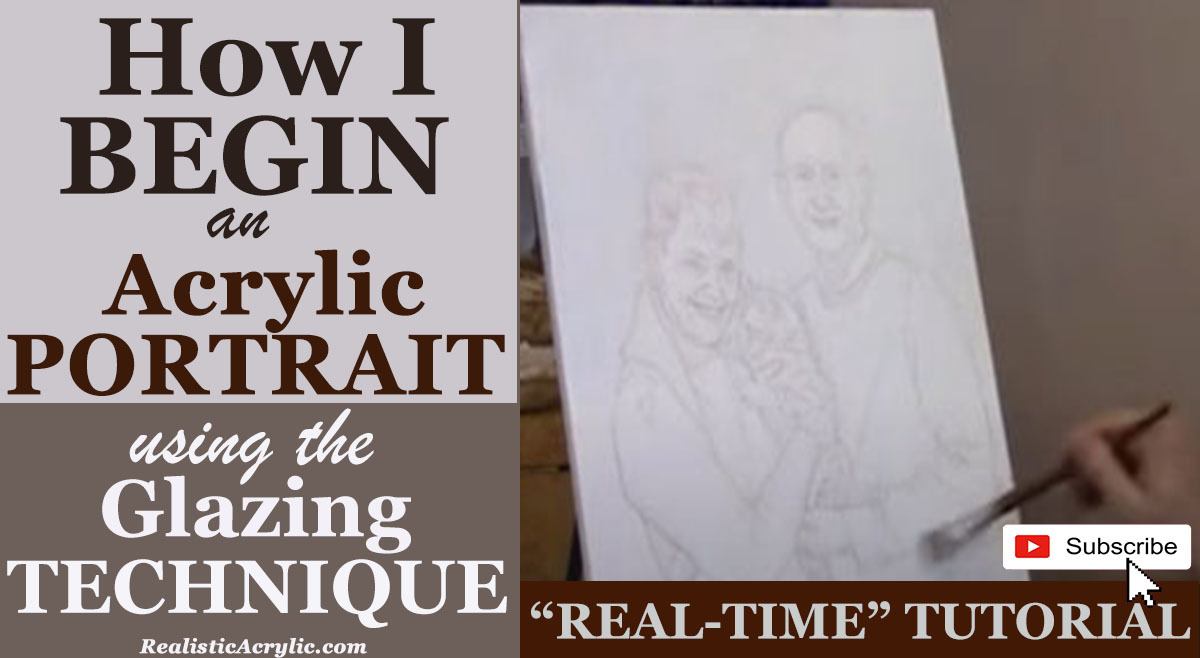
How to Begin an Acrylic Portrait Glazing Technique
Learn the basics of starting an acrylic portrait using the glazing technique, enhancing your art with smooth transitions and vibrant layers.
When starting an acrylic portrait, artists often encounter the challenge of creating depth and realism. Because one of the effective way to achieve this is through the glazing technique—a method that allows you to build up layers of translucent paint, adding nuance to your work. Because this article will guide you through the process of beginning an acrylic portrait using glazing, from planning your strategy to applying your first layers of paint. And then you’ll learn how to assess value structures, mix colors effectively, and develop a portrait that has depth and lifelike vibrancy.
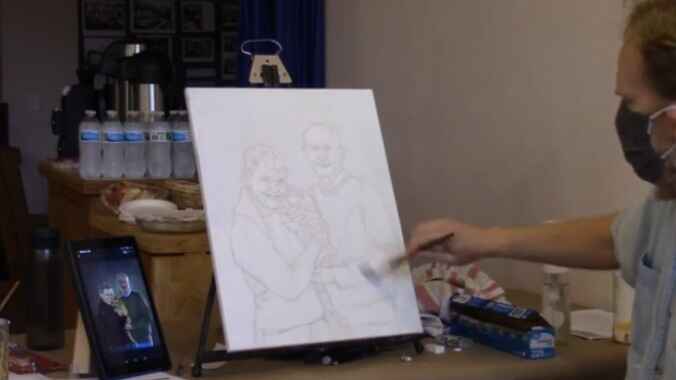
Step 1: Preparing for the Glazing Process
Before you dive into painting, it’s important to prepare your palette and understand the key elements that will guide your portrait. The first step involves assessing your reference photo. As I suggested, that you kind of want to plot out your strategy what you’re going to do and how you’re going to paint it.”
Observe the Value Structure
Value structure refers to the overall light and dark areas of your image. Carefully observe whether your subject’s face is lighter or darker than the background. Then this decision will guide your initial glaze and help build contrast.
For instance, if the background is darker and the face is lighter, your strategy should focus on enhancing this contrast. The glazing technique can help you subtly develop these transitions, bringing clarity and definition to your subject. Planning this early ensures a smooth painting process later on.
Step 2: Mixing Your Glaze
Glazing is all about transparency, and the key to a successful glaze lies in the mixture of matte medium and paint. I recommend the ratio is 90-95% matte medium and 5-10% paint. Then this ensures that your glaze is translucent and allows the layers beneath it to show through.
To begin, choose your colors based on the tones in your reference image. In this case, the artist begins with ultramarine blue and raw umber dark, creating a grayish tone that will serve as the first glaze for the background. He emphasizes using a small amount of paint, stating that you should mix a little bit of color at a time and then work it into the medium.
Tip for Mixing:
“Turn your brush over and swirl it,” the artist explains, “distributing the pigment onto the bristles evenly.” This helps to ensure smooth application when you start painting.
Step 3: Applying the First Glaze
Now that your glaze is mixed, it’s time to apply it to the canvas. Then start in the darkest areas of the painting, working your way towards the lighter sections. In this example, I began at the top left corner, which is the darkest area of the background.
One crucial aspect of glazing is to always keep a wet edge—this prevents harsh lines from forming and ensures smooth transitions between areas. As I demonstrated, when applying the glaze in multiple directions (horizontal and vertical strokes) helps to distribute the paint evenly.
Pro Tip:
Use a generous amount of glaze on your brush. “You need a lot of mixture on your brush to get it smooth,” as I advise. Because this helps minimize visible brushstrokes, which can detract from the overall smoothness of your portrait.
Step 4: Building Up Layers
One of the main advantages of the glazing technique is its ability to build up color gradually. In this initial phase, your focus is not on developing shadows or highlights yet; it’s about laying down a foundation layer that establishes the basic tones.
As you progress, each new glaze will add depth to the painting. The translucent nature of the glaze allows the underpainting to show through, creating a richer, more complex color.
Understanding Opacity and Transparency:
- Opaque: No light passes through the paint; it’s completely solid.
- Transparent: Light passes through fully, revealing the layers beneath.
- Translucent: Light partially passes through, which is the goal with glazing.
In the video, I demonstrate the concept using a white card with a black line drawn on it. The line is still slightly visible through the glaze, indicating that the mixture is translucent enough to let underlying layers peek through.
Step 5: Working with Edges
A common challenge when glazing portraits is managing the edges of your subject. Many beginners hesitate to paint over parts of their subject’s face or clothing, fearing they’ll ruin the work. However, leaving a “halo” or white space around the figure can be problematic; it’s much harder to fix later.
Don’t be afraid to go over on top of the people, the subjects.” You can always paint over areas like hair or clothing again, but it’s harder to match the background color if you’ve left an unpainted edge.
Key Technique:
Focus on smoothing the glaze around complex areas, like hair, by using light strokes and ensuring your brush has enough glaze on it. Because this helps maintain clean edges without hard lines.
Step 6: Creating Contrast and Depth
As you apply more layers of glaze, the contrast between light and dark areas will become more apparent. This is especially important in portrait painting, where creating depth in features like eyes, cheekbones, and jawlines adds realism.
The glazing technique is ideal for this because it allows you to slowly darken shadows and adjust highlights without overwhelming the painting. For instance, if a subject has dark shadows under their chin or behind their ear, you can build these shadows layer by layer, achieving a more realistic look over time.
Step 7: Final Thoughts on Glazing
The glazing technique is a powerful tool for acrylic portrait painters, providing a way to create depth, nuance, and smooth transitions. Because by using a combination of matte medium and a small amount of pigment, you can control the transparency of each layer, ensuring that your painting develops gradually and with precision.
Recap of Key Tips:
- Always observe the value structure of your reference photo before starting.
- Use a high ratio of matte medium to paint (90-95% medium).
- Apply glaze in the darkest areas first, working toward lighter areas.
- Keep a wet edge and apply the glaze in multiple directions for smoothness.
- Don’t be afraid to paint over parts of your subject, as it’s easier to fix later than to match an unpainted area.
- Build contrast slowly by adding layers of glaze to create depth and realism.
By following these steps, you’ll have a solid foundation for starting any acrylic portrait, ensuring that your painting is smooth, balanced, and full of life.
- Adding highlights to your acrylic painting
- 5 Excellent Reasons to Use Aluminum Foil
- Paint Realistic Wrinkles in Acrylic
- Painting Clothing in an Acrylic Portrait
- Paint a Cloudy Sky Acrylic
- How to add Semi-Opaque Highlights
- How to Enhance the Contrast in Your Acrylic
- How to Add Glaze to Your Acrylic Painting
- Paint Realistic Reflections on Eyeglasses in an Acrylic Portrait
- Build Up Depth on Your Acrylic Portrait Backgrounds
- How Do You Do Layers With the Glazing Technique?
- Learn How to Paint Wrinkles in Acrylic
Read more about how to paint a portrait that you can surely be proud of!
I’d love to hear your thoughts on this video. Please share it with your friends and family. Let me know if you have any further questions. I’ll greatly help you.
If you’d like to learn more, sign up for my free email tips and video class today.
Learn How to Paint Acrylic Portraits With My Free Mini-Video Course!
Thank you so much for taking the time to read this tutorial and watch the video. That means a lot to me. I hope you find it very helpful in your portrait painting.
Yours for Better Portraits,

P.S. Did you find this post helpful or encouraging? If so, send it on ahead! Let others know with the share buttons below. I’d love to hear your comments. Thank you so much! Also, do you have a question on acrylic portrait painting you’d like answered? Let me know, and I’d be happy to help!
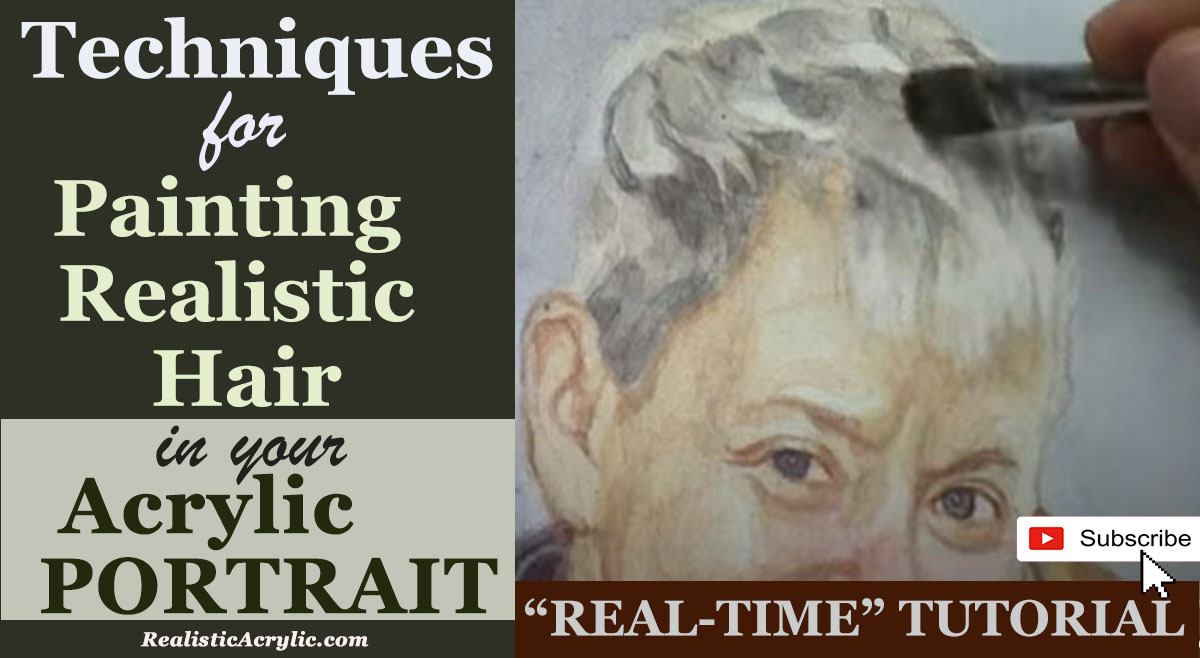
How to Paint Realistic Hair in Acrylic Portrait
Creating lifelike hair in acrylic portraits by using simple layering and glazing techniques.
Creating realistic hair in acrylic portraits can be challenging for many artists. However, with a few foundational techniques like glazing, layering, and understanding value shapes, the task becomes much more manageable. In this guide, I’ll walk you through the step-by-step process on how to paint realistic hair in an acrylic portrait, focusing on how to build depth, enhance vibrance, and add nuances through layering.
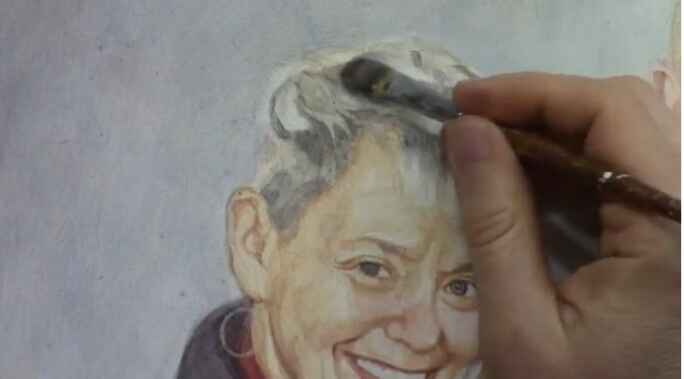
1. Understanding Glazing for Realism
The glazing technique is an excellent way to create depth, vibrance, and smooth transitions in acrylic paintings. It allows the artist to build color slowly, using thin layers of semi-transparent paint to adjust tones and values. When light shines through these layers, the colors appear richer, resembling the look of oil paintings.
For this portrait of a couple and their cat, I used this method extensively to paint their hair. The first step is to establish a light sketch on the canvas. Then, using multiple thin layers of paint, I gradually build up the color and value of the hair, which creates the illusion of volume and movement.
Tip:
Use a matte medium with your acrylic paint to make it more fluid without diluting the color too much, unlike water.
2. Layering and Building Gradually
Think of painting hair as similar to developing a photograph each layer adds more clarity. When painting hair, you don’t have to finish one section entirely before moving on. Instead, build the entire hair section up gradually with layers. This approach allows you to create smoother transitions between light and shadow, which is key to making the hair look realistic.
In the example of this painting, I began by blocking in mid-tone values, using a combination of burnt sienna, ultramarine blue, and raw umber. The dark tones in the hair were added in stages, with lighter highlights being reserved for later layers.
Tip:
Don’t be afraid to layer over your previous work. Acrylics dry quickly, making them ideal for building layers that add depth and realism.
3. Breaking Hair Down Into Shapes
One of the biggest challenges artists face when painting hair is getting overwhelmed by the fine details. Instead of trying to capture every single strand, think of the hair as a collection of abstract shapes. These shapes represent the shadows, mid-tones, and highlights within the hair.
As a result of focusing on these larger forms, you can create a more structured and realistic base. Because in this video, I demonstrate how to break down the hair into different value shapes, comparing them to geographical features like states and continents. This method helps simplify the process, making the task of painting hair less daunting.
Tip:
Don’t paint hair as individual strands. Instead, focus on grouping them into sections that follow the flow of the hairstyle.
4. Darkening and Adding Richness
Once the base shapes of the hair are laid out, the next step is to start adding depth by darkening certain areas. In this case, I used a mix of raw umber and ultramarine blue to darken the upper sections of the hair, creating contrast against the lighter highlights. Then the darker areas serve to define the shape of the hair, giving it a three-dimensional appearance.
The richness and depth of the hair are enhanced by applying glazes of semi-transparent paint. Then the glazing technique ensures that the darker tones blend seamlessly with the lighter ones, avoiding harsh transitions.
Tip:
Use a filbert brush to help blend the paint smoothly, especially when working on transitions between light and shadow.
5. Adding Highlights and Nuances
Lastly, the final step is to add the highlights and small nuances that bring the hair to life. Because highlights should be placed strategically to mimic the way light interacts with the hair. In this portrait, I used a small round brush to carefully apply titanium white mixed with a bit of yellow to the lighter sections of the hair. These highlights are what give the hair its shine and texture.
Tip:
Apply highlights sparingly and blend them gently into the surrounding areas to avoid a stark, unnatural look.
6. Creating Depth Through Value Shapes
An important concept to remember when painting hair is that it’s all about value shapes. Because value refers to the lightness or darkness of a color, and by using a range of values, you can create depth and form. In the painting, the hair was broken down into sections of dark, mid-tone, and light values, much like a map with different regions. Each value shape contributes to the overall structure of the hair, making it appear more realistic.
Tip:
Think of value shapes as the backbone of your painting. They give structure and guide the placement of details like highlights and shadows.
Conclusion
Painting realistic hair in acrylic portraits may seem challenging, but by following these techniques glazing, layering, and focusing on value shapes you can achieve beautiful, lifelike results. Remember to approach the task patiently, building up the hair gradually through multiple layers, and breaking the complexity of the hair into manageable shapes.
Because by practicing these methods, you’ll be able to create hair that looks natural and three dimensional in your portraits. Then, with time and dedication, the process will become second nature, and you’ll find joy in bringing your acrylic portraits to life.
If you found this guide helpful and would like to learn more about sketching or painting techniques, visit realisticacrylic.com for more tutorials and check out my free gift for you here.
- Adding highlights to your acrylic painting
- 5 Excellent Reasons to Use Aluminum Foil
- Paint Realistic Wrinkles in Acrylic
- Painting Clothing in an Acrylic Portrait
- Paint a Cloudy Sky Acrylic
- How to add Semi-Opaque Highlights
- How to Enhance the Contrast in Your Acrylic
- How to Add Glaze to Your Acrylic Painting
- Paint Realistic Reflections on Eyeglasses in an Acrylic Portrait
- Build Up Depth on Your Acrylic Portrait Backgrounds
- How Do You Do Layers With the Glazing Technique?
- Learn How to Paint Wrinkles in Acrylic
Read more about how to paint a portrait that you can surely be proud of!
I’d love to hear your thoughts on this video. Please share it with your friends and family. Let me know if you have any further questions. I’ll greatly help you.
If you’d like to learn more, sign up for my free email tips and video class today.
Learn How to Paint Acrylic Portraits With My Free Mini-Video Course!
Thank you so much for taking the time to read this tutorial and watch the video. That means a lot to me. I hope you find it very helpful in your portrait painting.
Yours for Better Portraits,

P.S. Did you find this post helpful or encouraging? If so, send it on ahead! Let others know with the share buttons below. I’d love to hear your comments. Thank you so much! Also, do you have a question on acrylic portrait painting you’d like answered? Let me know, and I’d be happy to help!
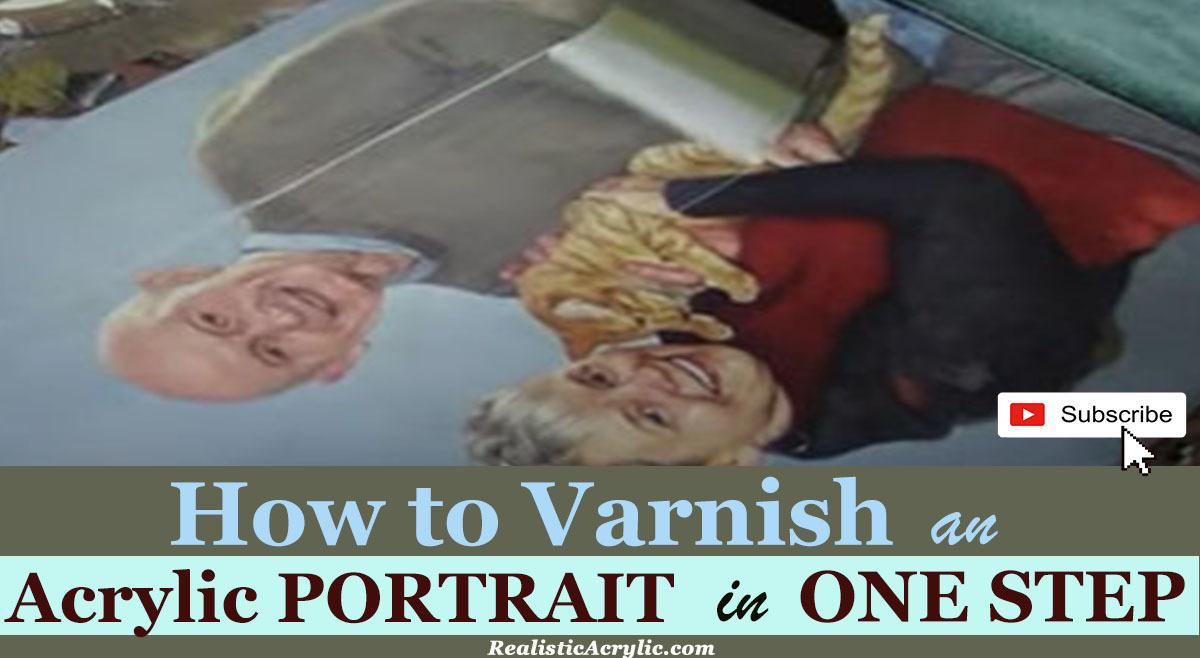
How to Varnish an Acrylic Portrait in ONE STEP
Learn the simple, foolproof method to varnish your acrylic portraits in one step, ensuring protection, enhanced color, and a professional finish.
When you’ve completed an acrylic portrait, you want to make sure it stands the test of time. Varnishing your artwork is the final touch that not only protects it but also enhances its appearance. Because in this tutorial, we’ll walk you through how to varnish an acrylic portrait in the one-step process, ensuring a professional, smooth finish every time.
Whether you’re new to varnishing or a seasoned artist, this simple technique will leave your acrylic portraits looking polished and ready to shine for years to come.
Why Varnishing Is Essential
Varnishing is often overlooked but is one of the most important steps in preserving your acrylic portraits. Here’s why you should varnish:
- Protection from Dust and Dirt: Varnish acts as a shield, protecting your painting from dirt, dust, and other environmental factors that could damage it over time.
- Prevents Scratches: It adds a layer of defense against accidental scuffs or scratches.
- Enhances Color and Depth: Varnish can bring out the depth and vibrancy in your colors, making your painting look more saturated and alive.
- Even Sheen for a Professional Finish: A good varnish gives your painting a consistent sheen, making it look more professional.

Preparing Your Workspace
Before you begin the varnishing process, it’s important to set up a clean, flat workspace. Unlike painting, where working vertically on an easel is common, varnishing must be done on a horizontal surface. If your painting is at an angle, the varnish can drip and dry unevenly, ruining the finish.
Step 1: Lay Your Painting Flat
Then place your painting on a flat table. To avoid picking up dust or dirt from the surface, elevate the canvas slightly. You can use items like jar lids or small wooden blocks to lift it off the table.
Step 2: Gather Your Materials
Here’s what you’ll need:
- Matte Varnish: For this tutorial, we recommend Nova Color Matte Varnish. Although labeled as matte, it dries to a satin finish, giving your painting a subtle sheen.
- Gloss Medium (Optional): Adding a bit of gloss medium (around 15%) can increase the shine of the varnish, giving it more vibrancy.
- Wide Flat Brush: A 10-inch flat brush works best for larger portraits (16×20 inches). For smaller portraits, use a 2-inch flat brush.
- Towel: Keep a towel nearby to wipe excess varnish from the brush.
Mixing and Preparing the Varnish
Step 1: Stir, Don’t Shake
Pour your varnish into a container, such as a clean yogurt container. Add about 15% gloss medium if you want a shinier finish. Use a whisk or a paint stir stick to thoroughly mix the varnish. Avoid shaking the container, as this can create bubbles that may affect the smoothness of the finish.
Step 2: Prepare Your Brush
Before dipping your brush into the varnish, lightly mist the bristles with water. This helps the varnish spread more evenly across the canvas.
Applying the Varnish
Step 1: Start in Sections
Dip your brush into the varnish, ensuring it’s evenly coated but not overloaded. When you start by applying the varnish about one-third of the way down the canvas. Brush in even strokes from top to bottom, making sure to overlap each section slightly.
Step 2: Use Long, Even Strokes
In this case, as you varnish, use long, smooth strokes to spread the varnish across the painting. Flip your brush over occasionally to ensure an even distribution. Avoid pressing too hard, as this can create streaks.
Step 3: Avoid Over-Brushing
One of the most common mistakes when varnishing is over-brushing. After applying the varnish in a few strokes, resist the urge to keep going over the same areas. Even if the varnish appears streaky or cloudy at first, it will dry clear. Over-brushing can cause the varnish to become uneven and may introduce unwanted bubbles.
If you’re looking for more instructional videos on how to improve your acrylic painting, visit www.realisticacrylic.com for more tutorials and check out my free courses here. .
- Adding highlights to your acrylic painting
- 5 Excellent Reasons to Use Aluminum Foil
- Paint Realistic Wrinkles in Acrylic
- Painting Clothing in an Acrylic Portrait
- Paint a Cloudy Sky Acrylic
- How to add Semi-Opaque Highlights
- How to Enhance the Contrast in Your Acrylic
- How to Add Glaze to Your Acrylic Painting
- Paint Realistic Reflections on Eyeglasses in an Acrylic Portrait
- Build Up Depth on Your Acrylic Portrait Backgrounds
- How Do You Do Layers With the Glazing Technique?
- Learn How to Paint Wrinkles in Acrylic
Read more about how to paint a portrait that you can surely be proud of!
I’d love to hear your thoughts on this video. Please share it with your friends and family. Let me know if you have any further questions. I’ll greatly help you.
If you’d like to learn more, sign up for my free email tips and video class today.
Learn How to Paint Acrylic Portraits With My Free Mini-Video Course!
Thank you so much for taking the time to read this tutorial and watch the video. That means a lot to me. I hope you find it very helpful in your portrait painting.
Yours for Better Portraits,

P.S. Did you find this post helpful or encouraging? If so, send it on ahead! Let others know with the share buttons below. I’d love to hear your comments. Thank you so much! Also, do you have a question on acrylic portrait painting you’d like answered? Let me know, and I’d be happy to help!
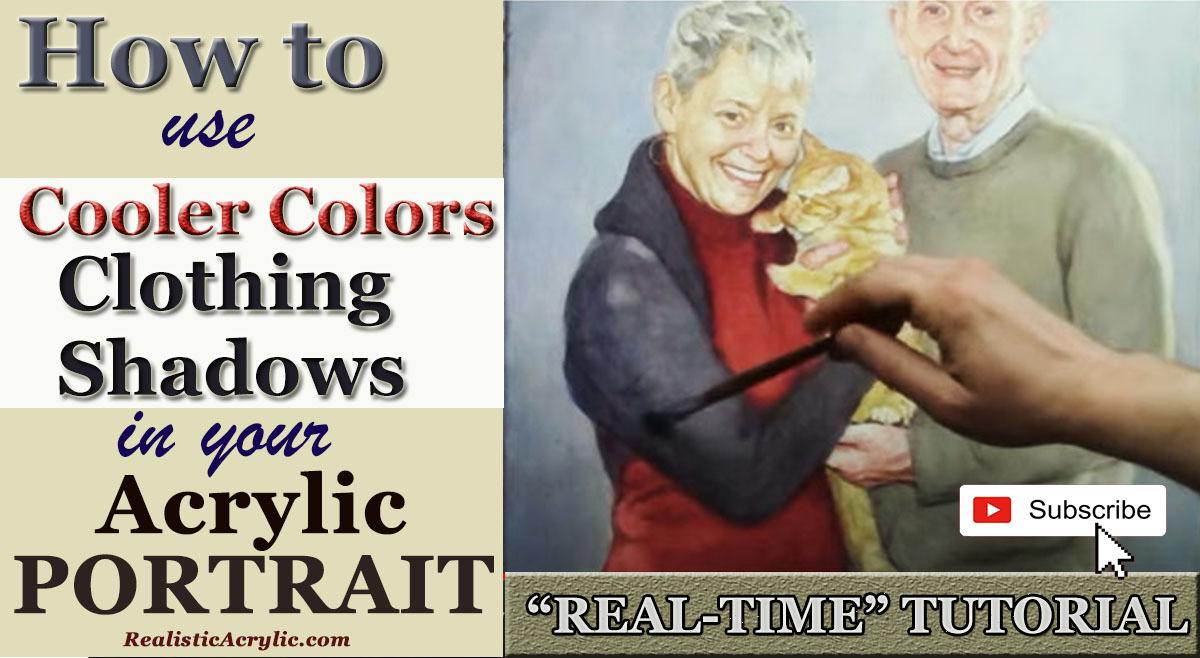
How to Use Cooler Colors for Clothing Shadow
Learning clothing shadows: Cool Color techniques for realism in acrylic portraits
Introduction: Enhancing Realism with Cooler Colors
In acrylic portrait painting, shadows play a pivotal role in creating depth and realism. One technique to elevate your work is using cooler colors for clothing shadow, an approach that may not be immediately obvious. By strategically incorporating cooler tones like blue and gray instead of relying solely on darker shades of the clothing color, you can achieve a subtle and realistic effect. In this tutorial, I’ll walk you through the process of applying cooler colors in clothing shadows using glazing and dry brush techniques to bring your painting to life.
Why Cooler Colors Work for Shadows
The instinct for many artists might be to darken the shadows on clothing with black or a deeper shade of the same color. However, this often leads to overly vibrant or unnatural results. By using cooler tones, such as blue or blue-gray, the shadowed areas can maintain their depth without overpowering the fabric’s natural color.
Key Tip:
When transitioning from light to shadow in your painting, cooler colors help tone down the vibrancy of the clothing while maintaining subtle value shifts.

Materials and Colors Used
For this technique, you’ll need a few specific tools and colors:
- Ultramarine Blue: A rich blue tone that works well for creating cooler shadows.
- Raw Umber Dark: A dark brown that adds depth to the blue without overpowering it.
- Matte Medium: A transparent acrylic medium to thin the paint for glazing.
- Flat Brush: Ideal for applying layers of glazes.
- Dry Brush: Perfect for gently feathering in the colors.
By combining these materials, you’ll have the perfect mix to start creating cooler-toned shadows.
Step 1: Mixing the Right Colors
Firstly, is create the right blend of colors for your shadows. Because in the video, I demonstrate how to mix ultramarine blue with raw umber dark. This combination creates a bluish-gray tone that is subtle and cool enough for shadows but still harmonious with the warmer base colors of the clothing.
Process:
- Begin by adding a small amount of ultramarine blue to your palette.
- Mix in a touch of raw umber dark to reduce the brightness of the blue.
- Incorporate matte medium to make the mixture more translucent, ensuring that the shadow layers don’t become too opaque.
This bluish-gray tone will not only darken the shadowed areas but also cool down the intensity, giving the clothing a realistic sense of depth.
Technique Tip:
Always mix small amounts of color first and test it on a separate surface, such as a white card, to see how it interacts with the base layer before applying it to your painting.
Step 2: Applying the Glaze
The glazing is a technique in which the thin layers of translucent paint are applied over dry areas of the painting, then allowing the underlying colors to show through. As a result, it creates a smooth transition from light to shadow without harsh lines.
Process:
- With a flat brush, apply your blue-gray mixture onto the darker areas of the clothing.
- Start by gently glazing the shadowed sections beneath folds, arms, or under the chin.
- Gradually build up the layers, allowing each one to dry before applying the next.
- The glazing process allows you to control the level of darkness and coolness in the shadow while ensuring that the red or other base color remains visible underneath.
Why It Works: The matte medium makes the glaze translucent, so the original clothing color can still be seen through the shadow, adding depth and subtlety to your portrait.
Step 3: Dry Brush Technique for Soft Blending
After applying your glaze, your next step is to use a dry brush technique to softly blend the cooler shadow into the surrounding areas of the clothing. The dry brush technique is particularly effective for adding texture and blending transitions in fabrics.
Process:
- Lightly load your brush with the blue-gray mixture.
- Dab off excess paint on a paper towel to create a dry brush effect.
- Gently stroke the brush over the edges of the shadows, using quick, soft motions to blend the glaze seamlessly into the lighter areas.
- Continue to feather the paint, allowing the cooler shadow to naturally merge with the highlights of the clothing.
Key Tip: The dry brush method allows for smooth transitions without harsh lines, then mimicking the way light softly falls on fabric in real life.
Step 4: Adjusting for Depth and Nuance
As you build the layers and blend your cooler shadows, you may notice that some areas need more depth or subtle variation. Don’t hesitate to adjust your mixture by adding more raw umber dark if the blue becomes too overpowering.
Important Consideration:
Then shadows should appear less vibrant and cooler as they get darker. And then by adjusting the mixture to include more raw umber dark, you can deepen the shadow without making it too cool or overwhelming.
Creating Realistic Clothing Shadows on Multiple Colors
The beauty of this technique is its versatility. You can apply the same blue-gray glaze to multiple fabric colors. For example, in the video, I use it both on the woman’s red clothing and on a man’s shirt. It works just as effectively on lighter-colored fabric, adjusting the tones slightly with each application.
Because by using the same cooler glaze across different fabrics, you create consistency in the shadows, making the portrait appear cohesive and well-integrated.
Conclusion: Mastering Shadows with Cool Tones
When incorporating cooler colors for shadows on clothing in your acrylic portraits allows for greater realism and depth. Because by utilizing a blue-gray glaze and dry brush blending, you can create nuanced shadows that seamlessly integrate with the base color of the fabric. Whether you’re working on bright red clothing or more muted tones, cooler shadows offer the perfect solution for achieving lifelike contrast and depth.
If you’re looking for more instructional videos on how to improve your acrylic painting, visit www.realisticacrylic.com for more tutorials and check out my free courses here. .
- How to Paint Foliage Using the Acrylic Glazing Technique
- How to Trace for an Accurate Portrait Sketch
- How to Paint Realistic Eyes in Your Acrylic Portrait
- How to Add Raw Umber Dark & Ultramarine Blue to Your Portrait
- How to Make Your Own Raw Umber Dark
- How to Paint Realistic Trees & Grass in Your Acrylic
- How to Block In Skin Tone Values Using Glazing Technique
- How to Paint Vibrant Reds in Your Acrylic Portrait
- How to Glaze Background Colors & More Acrylic Portrait
- How to Paint White Clothing in Your Acrylic Portrait
- How to Easily Transition from a Sketch to a Painting
- How to Block In Shading & Skin Tones in Your Acrylic
- How to Build Up Color on Acrylic Pet Portrait
- How to Build Up Form on Clothing with Acrylic
- How to Paint Dark Clothing Using Acrylic Glazing Technique
- How to Paint a 24 x 30 Acrylic With 30 People
- How to Do Smooth Shading with Acrylic
- How to Sketch an Acrylic Portrait with a Grid
Read more about how to paint a portrait that you can surely be proud of!
I’d love to hear your thoughts on this video. Please share it with your friends and family. Let me know if you have any further questions. I’ll greatly help you.
If you’d like to learn more, sign up for my free email tips and video class today.
Learn How to Paint Acrylic Portraits With My Free Mini-Video Course!
Thank you so much for taking the time to read this tutorial and watch the video. That means a lot to me. I hope you find it very helpful in your portrait painting.
Yours for Better Portraits,

P.S. Did you find this post helpful or encouraging? If so, send it on ahead! Let others know with the share buttons below. I’d love to hear your comments. Thank you so much! Also, do you have a question on acrylic portrait painting you’d like answered? Let me know, and I’d be happy to help!
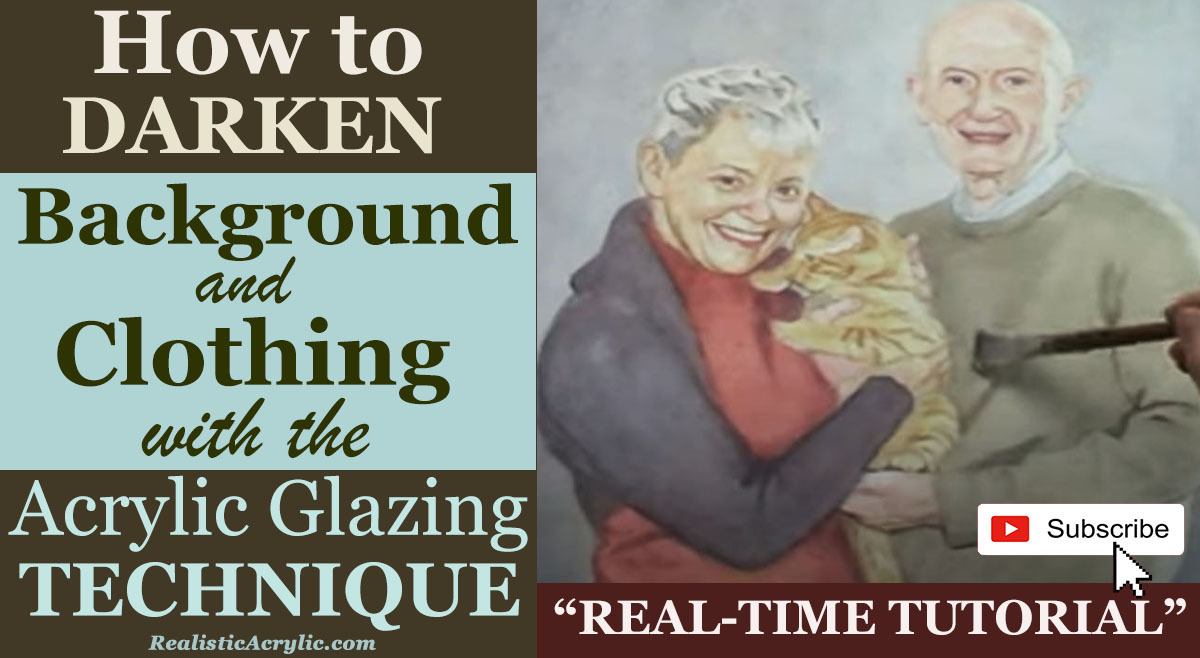
How To Darken Background & Clothing: Acrylic Glazing Technique
Discover the acrylic glazing technique to add depth, richness, and contrast to your portraits by darkening the background and clothing with ease.
One of the challenges portrait artists face is creating a balanced contrast between the subject and the background. Acrylic glazing is an excellent technique for solving this problem, offering the ability to subtly darken elements like the background and clothing while maintaining depth and luminosity. In this tutorial, we’ll explore how to use acrylic glazing to darken the background and clothing in your portraits. Then the key to success in this technique lies in building up light layers of color, allowing the paint to create a rich, oil-like effect that transforms your artwork.
Because at the end of this guide, you’ll be able to create striking contrasts, enhance the mood of your painting, and master acrylic glazing for darker tones.

Materials Needed
To achieve the best results with the acrylic glazing technique, you’ll need the following materials:
- Acrylic paints (ultramarine blue, burnt sienna, raw umber, titanium white, etc.)
- Matte medium (or glazing medium)
- Reference photo
- Various brushes (detail brushes, medium flat brush, and large round brush)
- Palette for mixing
- Water and a clean rag
Understanding Acrylic Glazing
Acrylic glazing is a technique where you mix a small amount of pigment with a large amount of matte medium to create thin, transparent layers of color. Each layer allows light to pass through, giving the painting added depth and richness. This technique mimics the effects of oil painting but with the faster drying time of acrylics, making it a versatile choice for many artists.
In this video, we follow the steps to darken the background and clothing of a 16×20 acrylic portrait of a couple and their cat. The key to achieving a smooth glaze is to ensure your base sketch is solid, allowing the layers to enhance rather than correct the painting.
Step 1: Starting with a Solid Sketch
Before applying glazes, it’s essential to have a strong and accurate sketch. As I have mention, that if you want to make sure that the proportions and likeness are perfect before you begin glazing. Because the foundation is key to a successful final product.
When creating your sketch:
- Focus on achieving correct proportions of your subject.
- Make sure the key areas such as the eyes, nose, and mouth are aligned.
- Use light pencil marks that won’t interfere with the transparency of your glaze.
Step 2: Mixing the First Glaze for the Background
In this painting, the client requested a bluish tone for the background. To create a blue glaze, follow these steps:
- Mix Ultramarine Blue: Add a small amount of ultramarine blue to your palette.
- Add Matte Medium: Mix the blue with matte medium until the paint is very translucent. Matte medium is milky white but dries completely clear, allowing the underlying layers to shine through.
- Apply the Glaze: Using short, choppy brush strokes, begin layering the blue glaze onto the background. This creates a smooth transition between the subject and background, enhancing depth.
One of the advantages of glazing is its flexibility. If the glaze looks too intense, you can always add more matte medium or water to lighten it.
Step 3: Building Up Contrast Between the Subject and Background
After applying the initial glaze, focus on enhancing the contrast between the subject (in this case, the couple and their cat) and the background. This step is crucial to making the subject stand out. You want to:
- Gradually increase the opacity of the glazes on the background to push it further into the distance.
- Use darker tones in the background compared to the foreground to create depth.
To darken the background even more, add layers of raw umber or burnt sienna mixed with matte medium on top of the blue glaze. This will give the background a more muted, shadowy effect while still allowing the initial blue tone to shine through.
Step 4: Glazing the Clothing
Next, shift focus to darkening the clothing using a similar glazing technique. The subject in this portrait is wearing darker-toned clothes, and I use the combination of raw umber and ultramarine blue to darken the clothing in a natural, gradual way.
- Mix Raw Umber and Blue: Combine raw umber with ultramarine blue and matte medium. This creates a nice neutral dark glaze that adds depth to the clothing without making it look flat.
- Apply the Glaze: Begin layering this darker glaze on the clothing, focusing on areas of shadow or where more depth is needed.
- Build Layer by Layer: Since glazing is a cumulative process, each layer adds more intensity to the clothing. Don’t worry about getting the perfect color right away. With each layer, the colors will mix and blend, creating a more realistic tone.
Remember, glazing allows you to make adjustments easily. If the color feels too cool or too warm, add a thin glaze of raw sienna or alizarin crimson to adjust the warmth or coolness.
Step 5: Enhancing Details and Finishing Touches
Once the base glazes are in place, use smaller detail brushes to enhance the finer areas, such as the edges of the clothing or folds in the fabric. For example, I use raw sienna to highlight certain areas of the shirt’s wrinkles. Then this subtle addition of color adds a lifelike quality to the painting.
At this stage, pay attention to:
- Wrinkles and folds in the clothing: Use a small brush to carefully apply thin glazes to highlight these details.
- Edge details: Glaze carefully around the edges where the subject meets the background, ensuring a smooth transition.
Tips for Acrylic Glazing Technique
- Use Light Layers: Always apply thin glazes and build up gradually. Heavy applications will obscure the previous layers.
- Dry Between Layers: Allow each glaze to dry before adding the next. This prevents muddying the colors.
- Experiment with Color: Don’t be afraid to adjust the color temperature with warm or cool glazes.
- Less Is More: A little pigment goes a long way when glazing. Be mindful of how much color you mix in with the medium.
- Work from Light to Dark: Build up your painting by working from lighter glazes to darker ones to maintain luminosity and depth.
Conclusion
The acrylic glazing technique offers artists a powerful tool for adding depth and richness to their paintings. When layering transparent color, you can gradually darken backgrounds and clothing without losing the vibrancy of the initial layers. This method also allows for flexibility, as adjustments can be made throughout the process without the pressure of getting it right on the first try.
In this painting of a couple and their cat, the careful use of glazing brings out the contrast between the subjects and their background, creating a compelling portrait. With practice, you’ll be able to master this technique and apply it to your own projects, transforming your portraits into luminous works of art.
If you’re looking for more instructional videos on how to improve your acrylic painting, visit www.realisticacrylic.com for more tutorials and check out my free courses here. .
- Adding highlights to your acrylic painting
- 5 Excellent Reasons to Use Aluminum Foil
- Paint Realistic Wrinkles in Acrylic
- Painting Clothing in an Acrylic Portrait
- Paint a Cloudy Sky Acrylic
- How to add Semi-Opaque Highlights
- How to Enhance the Contrast in Your Acrylic
- How to Add Glaze to Your Acrylic Painting
- Paint Realistic Reflections on Eyeglasses in an Acrylic Portrait
- Build Up Depth on Your Acrylic Portrait Backgrounds
- How Do You Do Layers With the Glazing Technique?
- Learn How to Paint Wrinkles in Acrylic
Read more about how to paint a portrait that you can surely be proud of!
I’d love to hear your thoughts on this video. Please share it with your friends and family. Let me know if you have any further questions. I’ll greatly help you.
If you’d like to learn more, sign up for my free email tips and video class today.
Learn How to Paint Acrylic Portraits With My Free Mini-Video Course!
Thank you so much for taking the time to read this tutorial and watch the video. That means a lot to me. I hope you find it very helpful in your portrait painting.
Yours for Better Portraits,

P.S. Did you find this post helpful or encouraging? If so, send it on ahead! Let others know with the share buttons below. I’d love to hear your comments. Thank you so much! Also, do you have a question on acrylic portrait painting you’d like answered? Let me know, and I’d be happy to help!
